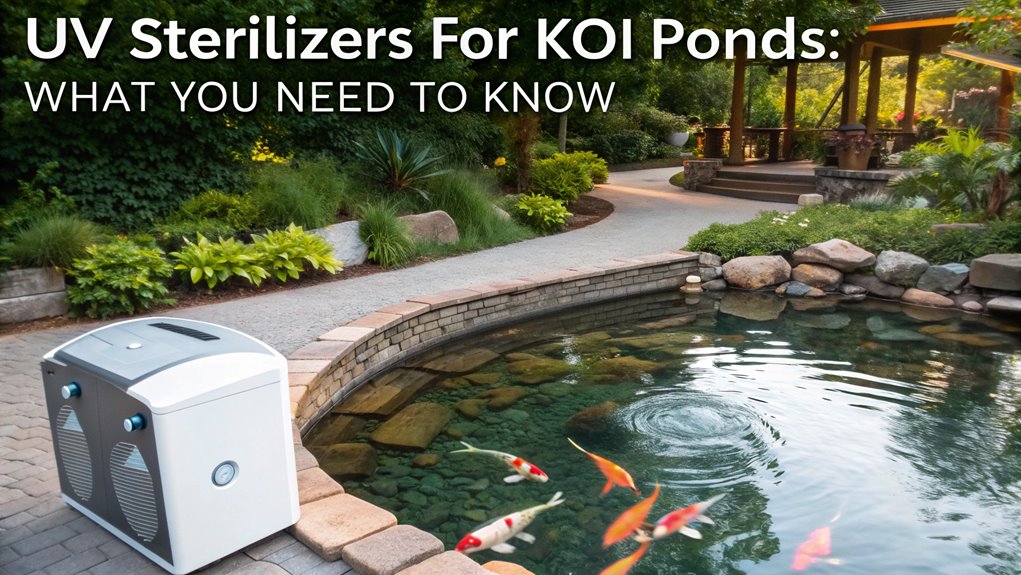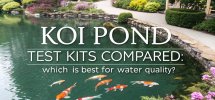UV sterilizers are crucial for maintaining koi pond health by eliminating harmful bacteria and parasites without chemicals. Achieving effective sterilization requires slower water flow and correct sizing—typically 30 watts per 1,000 gallons to avoid disrupting beneficial bacteria. Though they promote better water quality than clarifiers, UV sterilizers need regular monitoring and bulb replacement. Integrating them thoughtfully with biological filtration enhances pond ecosystems, especially in densely stocked ponds. Further exploration will provide deeper insights into their intricacies.
Key Facts Summarized
- UV sterilizers eliminate harmful bacteria and parasites, enhancing koi health without chemicals.
- Proper sizing of UV sterilizers is crucial, with 30 watts per 1,000 gallons recommended.
- Sterilizers require slow water flow rates for effective pathogen disruption.
- Annual bulb replacement is necessary to maintain sterilizer efficacy.
- UV sterilizers complement biological filtration but cannot replace it.
Understanding UV Sterilization in Koi Ponds
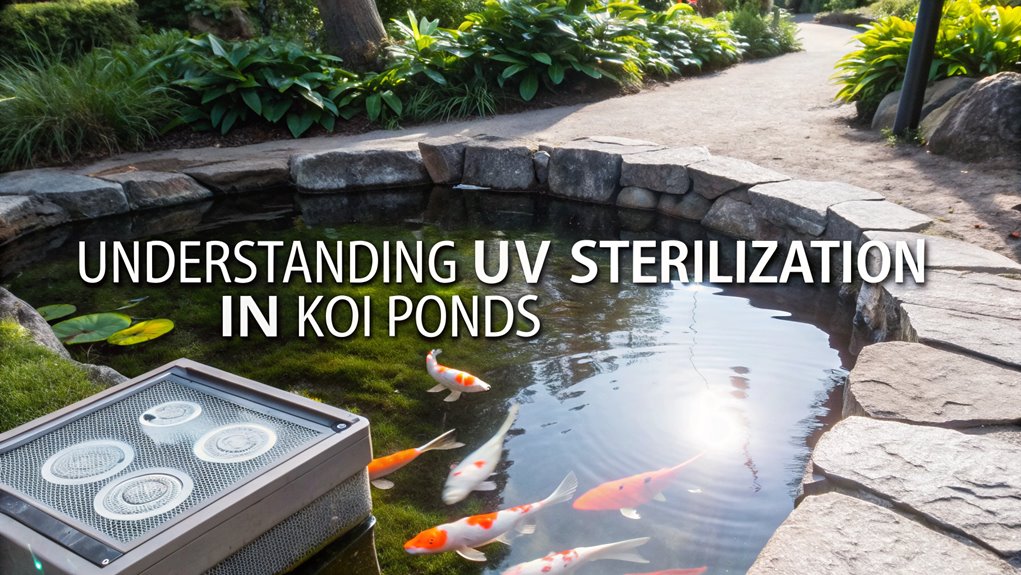
When it comes to maintaining a healthy environment for koi, understanding UV sterilization is crucial.
UV sterilizers are pivotal in water treatment for koi ponds, targeting harmful bacteria and parasites without relying on chemicals. As UV Clarifiers, they disrupt pathogen DNA by requiring slower water flow, which ensures efficiency.
However, sizing the unit correctly for your pond’s flow rate is essential to avoid overuse, which might unintentionally eliminate beneficial bacteria vital for your biological filter. Regular monitoring and bulb replacement are necessary to sustain their pathogen-reducing capabilities.
Benefits of Using UV Sterilizers for Koi Health
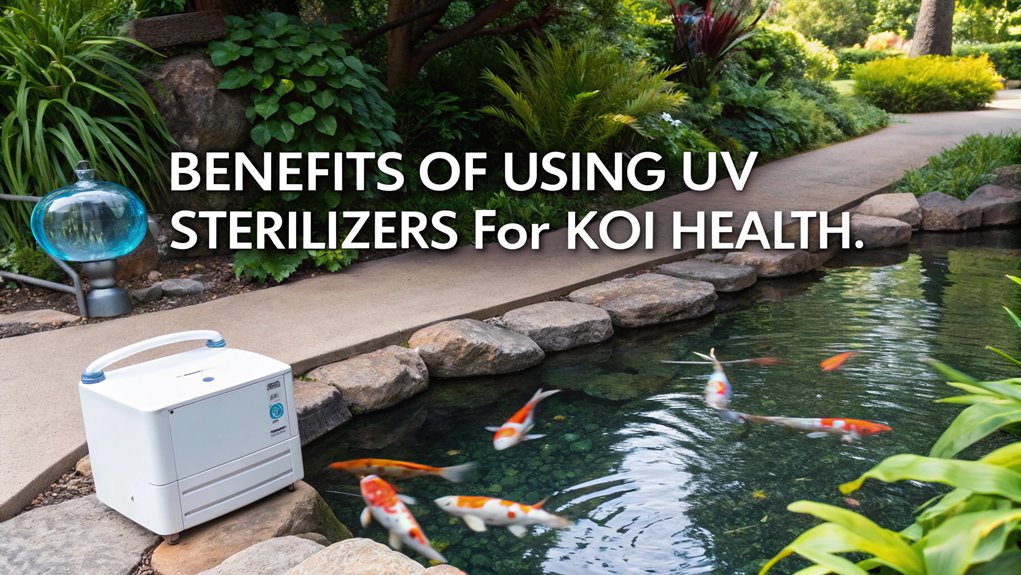
Effective UV sterilization plays a significant role in promoting koi health by directly targeting and eliminating harmful microorganisms.
UV sterilizers disrupt the DNA of pathogens, providing a chemical-free solution to maintaining optimal water quality. This method ensures a healthier environment for koi fish, significantly reducing the risk of disease outbreaks by lowering the presence of disease-carrying microorganisms.
By integrating UV sterilizers with biological filtration systems, you enhance the pond ecosystem’s overall health, creating a balanced habitat that supports thriving koi populations.
In ponds with high fish stocking density, the slower water flow required for effective UV treatment ensures comprehensive health management.
Thus, UV sterilizers are vital tools in sustaining long-term koi well-being and longevity within your pond ecosystem.
Key Differences Between UV Sterilizers and Clarifiers
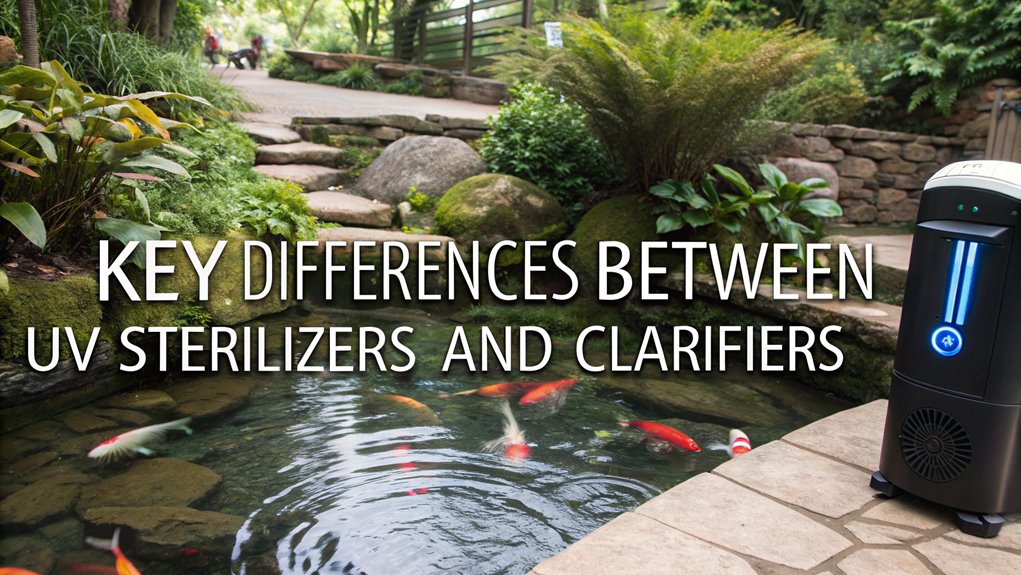
While both UV sterilizers and clarifiers employ ultraviolet light to improve pond conditions, their functions and operational focuses set them apart distinctly.
UV sterilizers target harmful microorganisms like bacteria and parasites, safeguarding koi health by disrupting their DNA. In contrast, UV clarifiers primarily aim to enhance water clarity by targeting single-cell algae, contributing to the pond’s aesthetic appeal.
Key differences include:
- UV sterilizers: Ensure disease prevention by eliminating harmful pathogens.
- UV clarifiers: Focus on clearing water for better visual appeal.
- Flow rates: Sterilizers require slower flow; clarifiers support faster flow.
- Operational goals: Sterilizers create a disease-free environment, while clarifiers control algae.
- Proper sizing: Essential for both to ensure effective treatment and maintain healthy pond ecosystems.
Additionally, maintaining optimal water quality is crucial for maximizing the effectiveness of both UV sterilizers and clarifiers in koi ponds.
Factors to Consider When Selecting a UV Sterilizer
Selecting the right UV sterilizer for your koi pond is essential for maintaining a healthy aquatic environment.
Ensure it’s properly sized—30 watts per 1,000 gallons is optimal for reducing bacteria and preventing disease.
Consider the maximum flow rate; your pond water should pass through the unit at least every two hours for effective pathogen control.
Compatibility with existing pumps and pipes is crucial; don’t exceed the sterilizer’s flow rate specifications.
Annual replacements of UV bulbs are vital, as their efficacy diminishes over time.
Evaluate your pond’s specific needs, including fish load and water quality, to decide between a standalone UV sterilizer or a UV filter combo.
Proper selection prevents green water issues and sustains your koi pond’s health.
Pros and Cons of UV Sterilizers in Pond Management
When managing a koi pond, understanding the pros and cons of UV sterilizers is crucial for effective pond health management.
UV sterilization employs light to eliminate harmful microorganisms, such as bacteria and parasites, safeguarding koi from disease. However, it’s not without drawbacks.
Consider these points:
- Pros:
- Enhances water clarity by reducing algae and pathogens.
- Protects koi health by preventing bacterial infections.
- Cons:
- Requires slower water flow, unsuitable for ponds prioritizing rapid circulation.
- Doesn’t replace a biological filter, necessitating additional systems.
- Overuse may disrupt beneficial bacteria, affecting pond equilibrium.
- Continuous operation can lead to high running costs.
Balancing these factors ensures UV sterilizers effectively support your pond’s ecosystem.
Exploring Natural Alternatives to UV Sterilization
Have you considered natural alternatives to UV sterilization for maintaining your koi pond’s health?
Promoting diatom growth can effectively combat algae proliferation, keeping ponds clear and reducing the dreaded green pond effect.
Integrating aquatic plants like water lilies and hornwort enhances natural filtration, offering essential habitat and shade, fostering a balanced ecosystem.
Regularly adding beneficial bacteria aids in breaking down organic waste, significantly improving water quality without relying on UV sterilizers.
Mechanical filtration systems, coupled with diligent maintenance practices such as debris removal and water circulation, play a crucial role in preserving pond clarity.
Frequently Asked Questions
Is There a Downside to UV Sterilizers?
Imagine coincidentally disrupting your pond’s ecosystem balance. UV sterilizers can eliminate beneficial bacteria, increase costs, interfere with medications, and fail if improperly sized. Overuse may destabilize the ecosystem, diminishing bacteria essential for organic waste breakdown and water quality.
Do UV Pond Filters Really Work?
You’ll find UV pond filters effectively reduce harmful bacteria, pathogens, and algae, ensuring clearer water. For optimal results, ensure proper sizing and flow rate. Remember, they complement biological filters, not replace them, for complete pond health.
How Often Should I Change the UV Bulb in My Pond?
Why, change your UV bulb annually, darling, lest your pond become a microbial utopia! Monitor water clarity like a hawk; if murkiness invades, consider an earlier switch. Align with manufacturer guidelines to maintain your aquatic Eden’s health.
Can You Have Too Much UV in a Pond?
Yes, you can have too much UV in a pond. Excessive UV exposure disrupts the ecosystem by killing beneficial bacteria. Ensure correct sizing and monitor water quality to prevent over-treatment and maintain a balanced, healthy pond environment.
Conclusion
In your journey to enhance koi health, using UV sterilizers can be a game-changer, acting like a guardian angel for your pond. By understanding their benefits and differences from clarifiers, you can make informed decisions. Consider factors like size and flow rate, weighing the pros and cons carefully. Remember, while UV sterilizers are powerful allies, exploring natural alternatives could also complement your pond management strategy, ensuring a balanced aquatic ecosystem that’s as vibrant as your koi.
